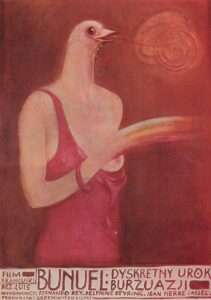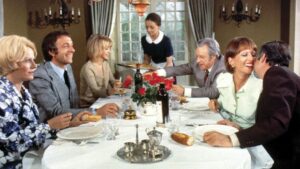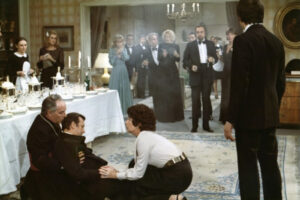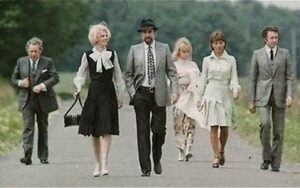“The Discreet Charm of the Bourgeoisie” – in The Fetters of Convention

Title: “The Discreet Charm of the Bourgeoisie” (Le charme discret de la bourgeoisie)
Release Date: 1972
Director: Luis Buñuel
Cast: Fernando Rey, Paul, Frankeur, Delphine Seyrig, Bulle Ogier, Stephane Audran, Jean-Pierre Cassel, Julien Berthau, Milena Vukotic, Claude Pieplu
Buñuel made a name for himself in the world of cinema as a rebel, and although the famous French triptych he made towards the end of his career is a bit more subdued in comparison with his earlier films, the director did not give up his trademarks. In “The Discreet Charm of the Bourgeoisie”, we find a satire on the bourgeoisie, surrealistic fantasies, and criticism of conventions.
“The Discreet Charm of the Bourgeoisie” opens Buñuel’s French period, considered by many to be the most outstanding of his career. Together with his next films, namely “The Phantom of Liberty” (1974) and “That Obscure Object of Desire” (1977), the work constitutes a true masterpiece of the Spanish director. The movie is set in France, and the main characters are two married couples, the unmarried sister of one of the women and a diplomat friend of the whole company.
They all belong to the country’s elite: Don Rafael (played by Fernando Rey) is the ambassador of the South American state of Miranda, who with his wealthy friends is involved in cocaine smuggling. He also does not fail to facilitate the jet trade with his poor country. They spend their free time, which they all have in abundance, together with beautiful ladies on common games and parties. They are also accompanied by the local church hierarch, who, in order to diversify his life, hires himself out as a gardener on the estate of one of the couples.

“The Discreet Charm of the Bourgeoisie” – inability to consume
“The Discreet Charm of the Bourgeoisie” has a casket-like composition, clearly referring to Wojciech Has’s “The Saragossa Manuscript”. It is therefore difficult to indicate a clear beginning and end to the narrative – one story contains another, which in turn triggers another. Moreover, we are dealing with a surrealistic mixture of reality and dream, which makes it impossible to separate the events from the characters’ nightmares. Each of the dreams presented by Buñuel reveals the deepest fears of the protagonists. Their common theme, however, is the sudden impediment to consumption – a sumptuous meal or a sexual act.
When the characters go to dinner together at a restaurant, for example, it turns out that prayers are being held over the body of the deceased owner. At another time, the dinner is interrupted by military maneuvers, and yet another time the entire company is arrested for drug trafficking just before the first course. The most telling scene in this context is the one where dinner is broken in by a terrorist attack – while the villains are shooting their victims, the ambassador, who is still alive and hidden under the table, takes advantage of the situation to eat the leftovers of the tasty roast. Eating, or rather animal devouring, as a symbol of a consumerist attitude to life, therefore becomes a more powerful instinct than the fear of death.
The same is true of erotic pleasure. Mr. and Mrs. Senechal (Stephane Audran and Jean-Pierre Cassel) invite friends to dinner, but instead of showing up at the table, they escape to the garden to make love. Thus, one carnal desire comes into conflict with another. And when Ambassador Acosta is about to make love to Simone (Delphine Seyrig), they are interrupted in their lewd frolicking by a surprise visit from the lover’s naive husband, Thevenot (Paul Frankeur).

“The Discreet Charm of the Bourgeoisie” – Freudian vision of culture
“The Discreet Charm of the Bourgeoisie” is a film that shows that food and sex define the basic horizon of upper class activities. The whole sphere of refined conventions is only a kind of camouflage, hiding the real human nature. One has to admit, however, that it is a very effective camouflage, and even, as Buñuel emphasizes, one with a genuine “charm”. Beautiful clothes, interiors, exquisite surroundings and impeccable manners – all serve to build a world of appearances. The vision of the Spanish director is therefore clearly consistent with the reflection of Freud, who was the first to notice that culture is nothing but the masking of predatory instincts.
Nevertheless, while for Freud the limitations of culture are a “source of suffering” for the individual, for Buñuel they have a “positive” function, as they make it possible to mask the true intentions, to which the telling epithet of the film’s title, “discreet” refers. Discretion becomes here identical with falsehood. Social convention also plays another role – it gives social relations a safe dimension. Furthermore, no one has to worry about the course of a meeting or conversation. At the same time, human interaction, due to convention, loses its authenticity and becomes just a game of empty forms.
“The Discreet Charm of the Bourgeoisie” – theater as Buñuel’s surreal nightmare
The motif of game appears in the dream of one of the protagonists of the film “The Discreet Charm of the Bourgeoisie”, Henri. A sophisticated company is invited to a party at the general’s house, but it turns out that the roast chickens served on the table are fake theatrical props. What is more, the curtain suddenly opens and the revelers find themselves on stage, where they are supposed to perform a play for the audience gathered in the theater. However, none of them can improvise, so they all flee in terror. This scene highlights the imprisonment of the upper class in a world of empty forms – their representatives are devoid of any authenticity.

The play of forms, in a truly Gombrowicz style, also involves the clergy. One of the film’s most important characters, Bishop Dufour (Julien Bertheau), is employed by the Senechal estate as a gardener. The perception of him changes depending on the outfit he is wearing – the workman’s clothes evoke disdain, while the cassock and the ring on his finger evoke admiration and respect. What is more, the bishop, despite his clerical function, is unable to rise above personal motives. When he discovers that the man to whom he is administering the last anointing is the murderer of his parents, after administering the sacrament, he simply kills him with a shot to the chest.
“The Discreet Charm of the Bourgeoisie” – irony instead of iconoclasm
“The Discreet Charm of the Bourgeoisie” is a film that is not, however, rebellious; it uses irony rather than iconoclasm. At its core is Buñuel’s mature and surprisingly up-to-date reflection on the essence of Western social order. It is a culture in which consumerism and postcolonialism remain the dominant tendencies. The latter, however, boils down to looking at the rest of the world from a position of privileged superiority.
A.Garbicz, “Kino, wehikuł magiczny. Przewodnik osiągnięć filmu fabularnego. Podróż czwarta: 1967 – 1973”, Kraków 2000.
E. Królikowska, “Śladami Buñuela. Kino hiszpańskie”, Warszawa 1988.
